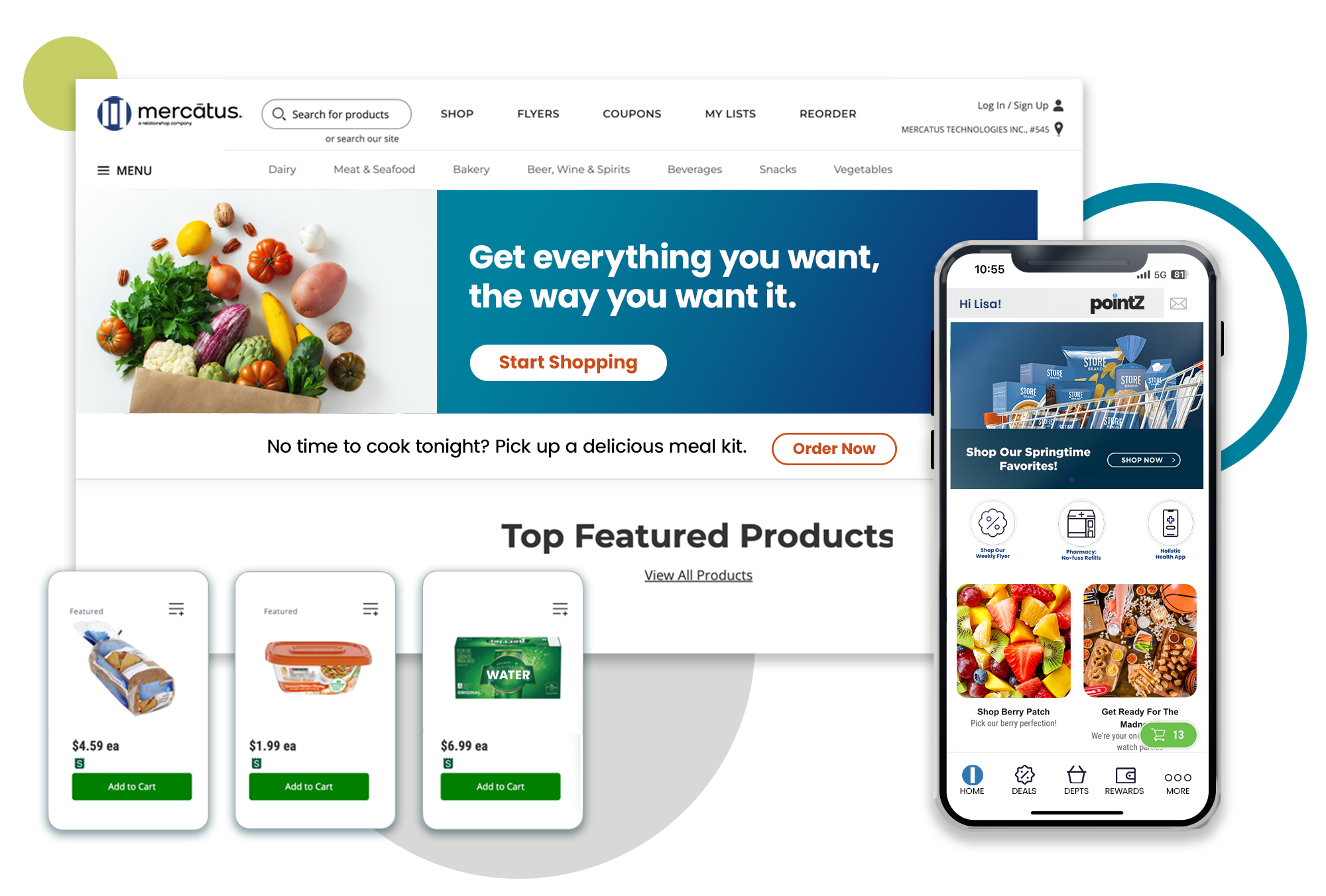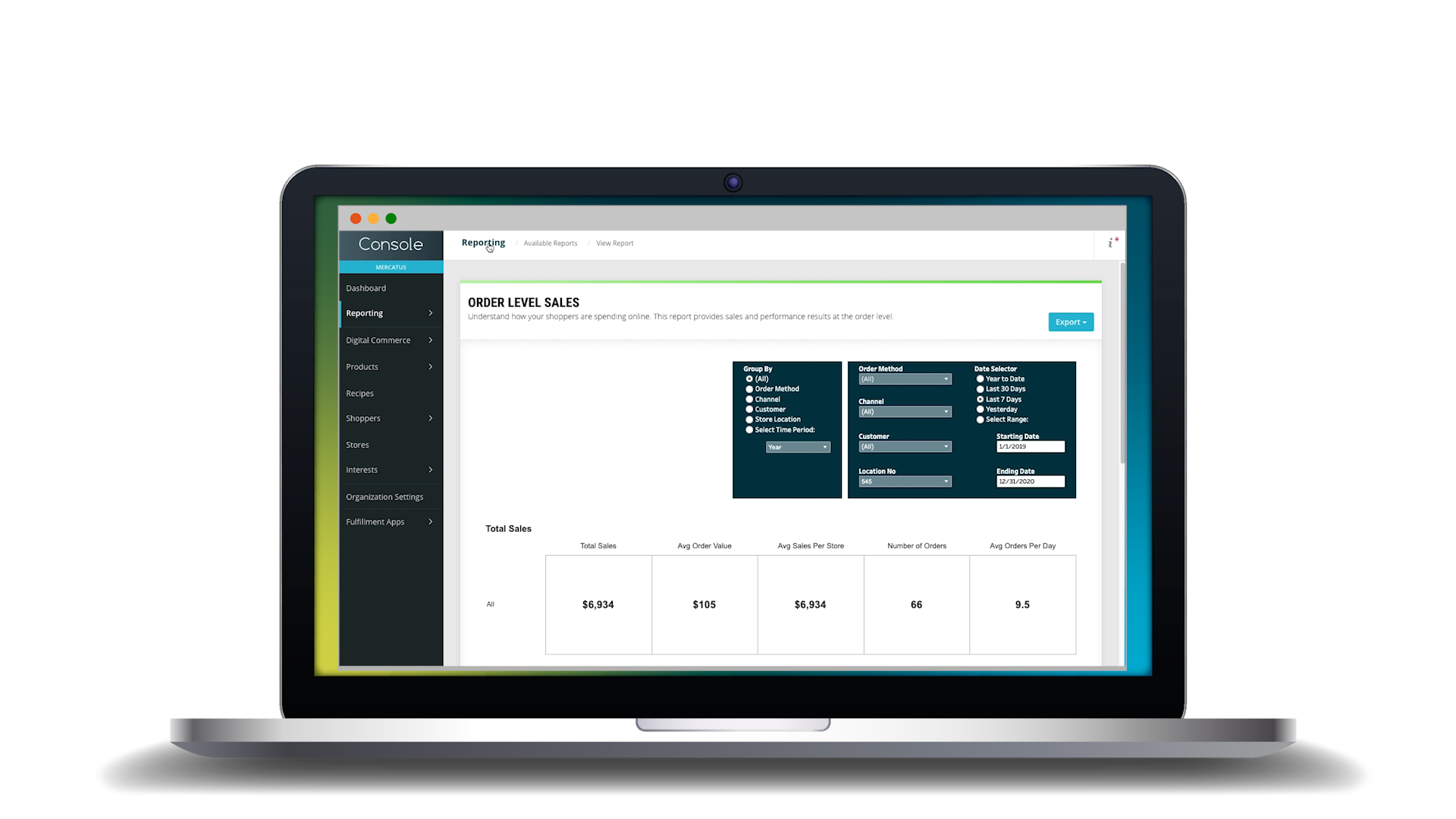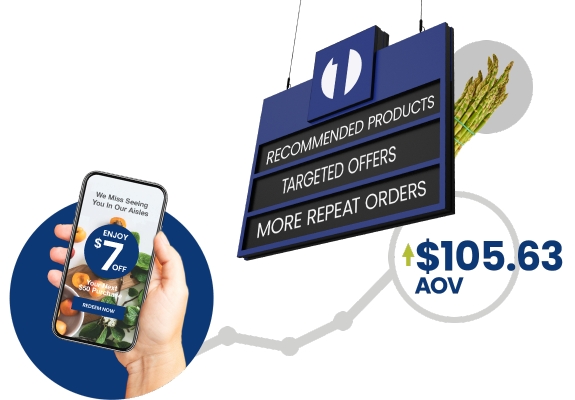Online Grocery Pickup: A Practical Guide To Create A Seamless Shopping Experience

Online grocery pickup has emerged as an in-demand service in the evolving grocery retail industry, offering customers a seamless way to shop without entering stores. This method allows consumers to place digital grocery orders online and conveniently pick them up at a designated time. As shoppers increasingly prioritize flexibility, safety, and speed, online grocery pickup has become a preferred solution for meeting these needs.
The rise of contactless shopping has been a key driver behind the adoption of online grocery pickup services. Many customers still appreciate the ability to avoid crowded stores while still accessing fresh groceries and household essentials. By offering a hybrid model of convenience and safety, grocers can bridge the gap between traditional shopping and fully digital solutions.
Customer convenience is another factor fueling this growth. With busy schedules and an increasing reliance on technology, shoppers value the ability to order groceries on their own time and pick them up without delays. Online grocery pickup reduces shopping time, simplifies the process, and provides a smooth experience for modern consumers.

In this article, we will explore key strategies to optimize e-commerce grocery services, improve operational efficiency, and improve customer satisfaction. By understanding the drivers and best practices behind online grocery pickup, grocers can meet growing demand and remain competitive in today’s digital-first market.
The Importance of Online Grocery Pickup Services
Online grocery pickup has become an essential component of an effective modern grocery strategy, addressing the changing needs of today’s consumers. This service combines the convenience of digital ordering with the flexibility of in-person fulfillment, catering to shoppers who value both efficiency and safety. As the demand for contactless solutions grows, online grocery pickup continues to play a critical role in maintaining competitiveness for retailers.
Offering online grocery pickup services is an opportunity for grocery businesses in the evolving grocery retail industry. Driven by trends started during covid like curbside pickup and contactless shopping, consumers have gotten used to the convenience and practicality of pick up services.
By offering convenience, affordability, and flexibility, pickup services complement delivery solutions and provide a seamless omnichannel experience. Grocers who invest in optimizing online grocery pickup can effectively meet consumer demands, improve operational efficiency, and strengthen their competitive edge.
Consumer Needs Fueling Curbside Pickup and Contactless Fulfillment Services
The rise of curbside pickup and contactless fulfillment is one of the most prominent trends driving online grocery pickup adoption. These options respond to consumers’ ongoing demand for safer and more convenient ways to shop.
- Safety and Convenience: Shoppers can retrieve orders without entering the store, ensuring a quick, hassle-free, and contactless experience.
- Pandemic-Driven Behavior: The pandemic accelerated this trend, and consumers now expect these services as part of their regular shopping routines.
- Operational Efficiency: Grocers benefit by streamlining fulfillment operations while reducing congestion inside stores during peak hours.
By prioritizing curbside pickup, grocers create an accessible and customer-centric solution that aligns with evolving shopper expectations.
Grocery Delivery Pickup and Delivery Services
While grocery delivery services offer doorstep convenience, online grocery pickup provides a valuable alternative for cost-conscious and time-efficient shoppers. Together, these services form a robust omnichannel strategy that meets varying consumer needs.
- Cost-Saving Option: Pickup eliminates delivery fees, making it an affordable choice for budget-conscious customers.
- Flexible Fulfillment: Customers can choose their preferred option based on urgency, with pickup often offering same-day availability at a lower cost.
- Operational Balance: Grocers can distribute order fulfillment across delivery and pickup services to improve overall efficiency and reduce delivery bottlenecks.
The combination of delivery and pickup services ensures that grocers are able to cater to a wide range of customer preferences, enhancing loyalty and satisfaction.
Leading Strategies to Drive Profitability in Grocery Pickup Services
Optimizing grocery pickup services is essential for grocers to improve profitability, reduce costs, and enhance customer satisfaction. By streamlining operations, leveraging technology, and prioritizing convenience, businesses can deliver efficient online grocery pickup solutions that meet growing consumer demand while maintaining operational excellence.
Driving profitability in grocery pickup services requires a strong focus on order fulfillment, advanced technology, customer convenience, and operational efficiency. By implementing strategies like streamlined workflows, flexible scheduling, and automation, grocers can deliver exceptional online grocery pickup experiences while improving margins.
Optimize Order Fulfillment Processes
Efficient order fulfillment is the backbone of profitable grocery pickup services. Streamlining workflows and scheduling can significantly reduce labor costs and improve resource utilization.
- Reduce Labor Costs: Assigning specific pickup time slots evenly distributes order fulfillment throughout the day. This reduces staff overload during peak hours and ensures that resources are managed efficiently.
- Implement Efficient Routing for Order Assembly: Optimizing picking routes ensures employees gather items quickly and minimize unnecessary movement. Well-organized systems help reduce errors and improve speed.
- Centralize Pickup Management Areas: Creating a designated area for pickups allows for smoother handovers and reduces wait times. This organization improves customer experience and streamlines operations for staff.
Efficient fulfillment processes ensure orders are accurate, reduce labor costs, and enhance the overall pickup experience for customers.
Develop Technology Solutions
Technology plays a significant role in managing digital grocery orders and ensuring seamless customer experiences. By implementing advanced tools, grocers can improve accuracy, operational control, and speed. Integrated grocery app ordering systems allow customers to place and manage orders with ease while enabling grocers to process orders in real time.
- Improve Inventory Visibility: Real-time inventory tracking ensures products listed as available are in stock, reducing substitutions or disappointments. This improves customer satisfaction and reduces unnecessary refunds or complaints.
- Automate Communication with Customers: Automated notifications, such as order confirmations, pickup reminders, and real-time status updates, improve transparency and ensure customers remain informed throughout the process.
By adopting smart technology solutions, grocers can enhance efficiency, improve accuracy, and deliver a smoother experience for customers.
Promote Customer Convenience
Convenience is a major driver for online grocery pickup adoption. Providing flexible options and incentives ensures customers continue using these services while fostering loyalty. Allowing customers to choose between in-store pickup and curbside pickup with time-slot options makes the service more adaptable to individual schedules. Same-day pickups further enhance convenience.
- Provide Loyalty Benefits for Frequent Pickup Customers: Rewarding loyal customers with discounts, loyalty points, or exclusive perks for frequent pickups builds retention and incentivizes consistent usage. Personalized offers increase engagement.
- Simplify Pickup Processes: Implementing systems for digital check-ins or app-based confirmations minimizes wait times and makes the handover seamless. Quick, hassle-free pickups encourage repeat customers.
By focusing on convenience, grocers can build a loyal customer base and differentiate their grocery pickup services from competitors.
Elevate Operational Efficiency
Operational efficiency means grocers can fulfill high volumes of digital grocery orders without increasing costs or compromising quality. Streamlined processes help grocers remain profitable and competitive.
- Implement Batch-Picking Techniques: Batch-picking allows staff to process multiple orders at once, reducing the time spent navigating aisles and improving productivity. This technique speeds up fulfillment and reduces resource waste.
- Use Real-Time Tracking: Tools that track the status of orders in real time help monitor progress, ensure timely handovers, and provide transparency to customers. This reduces delays and errors.
- Optimize Staffing Based on Demand: Analyzing peak order times helps grocers allocate staff effectively, avoiding both underutilization and overstaffing. Proper planning ensures smooth operations even during busy periods.
Improving operational efficiency allows grocers to improve resource utilization, reduce costs, and handle higher order volumes seamlessly.
Optimizing Grocery Fulfillment: Reducing Costs and Improving Efficiency
Optimizing retail fulfillment services is essential for grocers to remain competitive in the rapidly growing grocery e-commerce market. Fulfillment efficiency directly impacts profitability, customer satisfaction, and the ability to scale operations. By reducing overhead costs, streamlining workflows, and leveraging technology, grocers can improve efficiency and ensure customers receive their orders quickly and accurately.
Techniques like “bag-as-you-go,” staff training, and real-time monitoring are essential for reducing errors and enhancing order accuracy. By implementing these strategies, grocers can improve operational efficiency, meet customer expectations, and drive long-term success in the competitive grocery e-commerce industry.
Reducing Overhead Costs in Retail Fulfillment Services
Controlling overhead costs is critical for maintaining healthy margins in grocery fulfillment operations. High labor expenses, inefficient processes, and unnecessary handling often drive up costs.
- Optimize Labor Schedules: Align staffing with peak order times to prevent overstaffing during slow periods while ensuring adequate resources during busy hours.
- Minimize Handling Steps: Streamline processes to reduce unnecessary product touches, saving time and labor costs.
- Consolidate Resources: Centralizing fulfillment hubs or using micro-fulfillment centers reduces operational costs and improves order turnaround times.
A focused approach to reducing overhead costs enables grocers to maintain competitive pricing and streamline operations without compromising quality.

Importance of Workforce Training and Technology Integration
A well-trained workforce and the integration of advanced technologies are key to optimizing retail fulfillment services. Workforce training ensures accuracy and efficiency, while technology supports automation and reduces manual errors.
- Invest in Staff Training: Proper training in picking, packing, and quality control ensures employees can complete orders accurately and efficiently. Staff confidence improves productivity.
- Leverage Automation Tools: Integrating technology, such as handheld picking devices, barcode scanners, and AI-driven software, increases efficiency and reduces errors.
- Real-Time Monitoring: Tools that track order progress help monitor fulfillment stages, ensuring timely delivery and minimizing bottlenecks.
Combining workforce development with modern technology empowers grocers to improve fulfillment speed, accuracy, and scalability.
Strategies for Reducing Errors and Improving Order Accuracy
Order accuracy is essential for maintaining customer satisfaction and loyalty in grocery e-commerce. Errors in picking or substitutions can lead to dissatisfaction, increased costs, and loss of repeat business.
- Implement Quality Control Checks: Adding a final verification step before delivery or pickup ensures that items are correct and meet quality standards.
- Utilize Inventory Management Systems: Real-time inventory tracking prevents stockouts, ensuring accurate fulfillment and minimizing the need for substitutions.
- Adopt Error-Reduction Technology: Barcode scanning and automated alerts during the picking process reduce human error and improve order accuracy.
Focusing on order accuracy reduces returns, increases customer trust, and enhances the overall shopping experience. Optimizing grocery fulfillment services requires a strategic focus on reducing overhead costs, minimizing handling time, improving workforce efficiency, and leveraging technology.
Building a Customer-Centric Pickup Service: Delivering Value and Convenience
Creating a customer-centric pickup service is essential for meeting modern shoppers’ expectations in the grocery e-commerce market.
With an increasing demand for contactless shopping, retailers must design pickup solutions that focus on convenience, value, and flexibility. By prioritizing customer preferences and offering value-driven features, grocers can strengthen loyalty and encourage repeat usage of pickup services.
Features like no-fee options, bundled promotions, and adaptable pickup services enable grocers to cater to evolving customer needs. These strategies enhance convenience and satisfaction while positioning retailers to succeed in the competitive grocery e-commerce market.
Prioritizing Customer Preferences for Contactless Shopping
Consumers increasingly value contactless shopping for safety, speed, and ease of use. By optimizing pickup services to align with these preferences, grocers can deliver a smooth and worry-free shopping experience.
- Seamless Pickup Process: Implement simple, app-based check-in options or digital alerts to notify staff when customers arrive, ensuring swift handovers.
- Curbside Options: Offer curbside pickup where customers can remain in their vehicles while groceries are loaded, prioritizing safety and convenience.
- Clear Instructions: Provide easy-to-follow directions for pickup locations, ensuring a hassle-free experience and reducing customer confusion.
By focusing on contactless solutions, grocers cater to shoppers who prioritize both efficiency and safety.
Value-Driven Solutions Like No-Fee Pickups and Bundled Offers
Offering value-added solutions like no-fee pickups and bundled promotions enhances the attractiveness of online grocery pickup services. Customers are more likely to choose pickup options when they see tangible benefits.
- No-Fee Pickups: Waiving service fees for pickup orders encourages budget-conscious shoppers to use the service more frequently, driving adoption and loyalty.
- Bundled Offers: Create exclusive product bundles such as meal kits or family packs that are available for pickup orders. This increases basket sizes and offers value to the customer.
- Promotional Incentives: Provide discounts or loyalty points for customers who regularly use pickup services, adding long-term value and improving retention.
Value-driven strategies give shoppers practical reasons to choose pickup over alternative fulfillment options.
Customizing Retailer Pickup Policies for Better Shopping Flexibility
Flexible retailer pickup policies are critical to providing convenience and meeting diverse customer needs. By offering adaptable solutions, grocers can accommodate individual preferences and schedules.
- Flexible Pickup Time Slots: Allow customers to select convenient pickup windows, including same-day and after-hours options, to align with their busy routines.
- Order Modifications: Enable customers to update or modify orders shortly before pickup, improving satisfaction and reducing frustration caused by last-minute changes.
- Extended Pickup Holds: Offer extended hold times for delayed pickups, giving customers more flexibility without added pressure.
Customized pickup policies ensure a seamless experience, helping grocers build stronger relationships with their customers. Building a customer-centric pickup service requires a strong focus on contactless shopping, value-driven solutions, and flexible policies.
How Technology Can Streamline Your eGrocery Pickup Operations
Integrating advanced technology into grocery e-commerce operations is essential for improving efficiency, reducing errors, and meeting growing customer demand. As pickup services become a preferred choice for shoppers, leveraging software solutions and data-driven tools allows grocers to streamline workflows, optimize resources, and deliver an exceptional experience for grocery delivery services and pickup orders.
Advanced software, integrated platforms, and data-driven decision-making tools ensure accurate order management, optimized pickup time slots, and seamless operations. By adopting these solutions, grocers can meet growing customer expectations while maintaining efficiency and profitability in the competitive grocery e-commerce industry.
Advanced Software Solutions for Grocery E-Commerce Success
Modern software tools play a key role in managing and automating the various stages of eGrocery pickup operations. From order processing to customer communication, these solutions improve operational accuracy and efficiency.
- Order Management Systems: These tools automate the entire order lifecycle, from online purchase to pickup handover, reducing errors and speeding up fulfillment.
- AI-Driven Fulfillment Tools: Artificial intelligence analyzes order volume and store layouts to optimize picking routes, saving time and labor during order assembly.
- Customer-Focused Apps: Seamless integration with apps allows customers to place, track, and modify orders in real time, improving the overall shopping experience.
Advanced software tools are critical for increasing productivity and ensuring smooth grocery e-commerce operations.

Benefits of Integrated Platforms for Grocery Delivery and Pickup
Integrated platforms allow grocers to manage both grocery delivery services and pickup orders from a single system. This unified approach reduces complexity and enhances efficiency for both fulfillment methods.
- Centralized Management: Integrated systems provide a consolidated view of orders, allowing grocers to allocate resources efficiently and reduce errors.
- Improved Coordination: These platforms enable better communication between warehouse staff, pickup teams, and customers, ensuring accurate and timely fulfillment.
- Scalable Operations: A unified platform makes it easier to scale operations as demand increases, supporting both delivery and online grocery pickup seamlessly.
By streamlining management across services, integrated platforms help grocers improve speed and accuracy while reducing operational friction. Data-driven insights ensure efficient resource utilization while improving the overall experience for customers using grocery pickup services.
Conclusion
Enhancing and optimizing online grocery pickup services requires a strategic focus on operational efficiency, customer satisfaction, and advanced technology integration. By streamlining order fulfillment processes, leveraging data-driven insights, and offering customer-centric solutions like flexible scheduling and contactless pickup, grocers can create a seamless and reliable shopping experience. These strategies improve resource utilization and build long-term customer loyalty.
As the demand for grocery e-commerce continues to grow, retailers must prioritize innovation and efficiency to remain competitive. By investing in technology, refining workflows, and aligning services with customer needs, grocery retailers can strengthen their position in the market.
Now is the time for grocers to elevate their grocery e-commerce strategy, ensuring they meet evolving consumer expectations and achieve sustainable growth.
Frequently Asked Questions
How does online grocery pickup work?
Online grocery pickup allows customers to place orders through a website or grocery app ordering system, select a preferred pickup time, and retrieve their groceries from a designated store location or curbside.
Can someone else pick up my grocery order on my behalf?
Yes, most retailers allow someone else to pick up your grocery order. Ensure the person has the order confirmation, proper identification, and any necessary instructions, such as a verification code, to complete the pickup successfully.
What should I do if an item in my order is unavailable?
If an item is unavailable, retailers often provide substitutions based on your preferences. You can opt to accept suggested replacements, decline substitutions during checkout, or request a refund for missing items, ensuring flexibility in managing your order.
How do I modify or cancel my online grocery pickup order?
You can modify or cancel your order through the retailer’s website or app, typically before the store begins fulfillment. Changes may include adding or removing items or rescheduling the pickup time.
What measures are in place to ensure contactless shopping during pickup?
Retailers implement contactless shopping by offering curbside pickup where groceries are loaded into your vehicle without physical contact. Payment is completed online, and digital check-ins or notifications further streamline the process for a safe and hassle-free experience.
How do substitutions work in online grocery pickup orders?
Substitutions occur when an item in your order is unavailable. Retailers typically replace it with a similar product of equal or higher quality.